Jane Keightly discovers the wonderful world of truffles at perhaps the most famous truffle fair in all of Italy: The Alba White Truffle Fair…
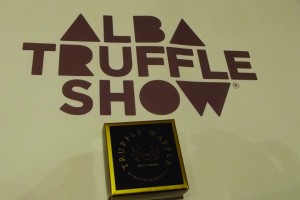 One of Italy’s most interesting seasonal events is the truffle season in Piedmont, when food lovers from all over the world descend upon the town of Alba for the International White Truffle Fair. I recently got a chance to visit this prestigious event and it made me realise just how little I had known about this beautiful region. As well as being the area where the Slow Food Movement originated there is a wonderful selection of vineyards to visit. It is also well known for its hazelnuts – one of the biggest employers in the area is Ferrero, who make Nutella and the famous Ferrero Rocher chocolates – and there is a Honey Route you can follow too.
One of Italy’s most interesting seasonal events is the truffle season in Piedmont, when food lovers from all over the world descend upon the town of Alba for the International White Truffle Fair. I recently got a chance to visit this prestigious event and it made me realise just how little I had known about this beautiful region. As well as being the area where the Slow Food Movement originated there is a wonderful selection of vineyards to visit. It is also well known for its hazelnuts – one of the biggest employers in the area is Ferrero, who make Nutella and the famous Ferrero Rocher chocolates – and there is a Honey Route you can follow too.
Alba is situated in the Langhe Roero region of Piedmont, which has recently been designated a Unesco World Heritage Site. October and November are the best months to visit, when the White Truffle Fair is held in the centre of the town – though it is well worth a visit any time of the year.
The Fair is currently held over six weekends from the second week of October to the third week of November, and many events are organised to coincide with it, such as wine tastings and art exhibitions. The Fair has also become better known thanks to the award of Truffle of the Year to an international or Italian personality. Celebrities who have visited Alba to collect their truffle include Sophia Loren, Luciano Pavarotti, Gérard Depardieu, Sting and Penélope Cruz. At the end of the Truffle Fair an International Truffle Auction is also held, the profits of which go to charity.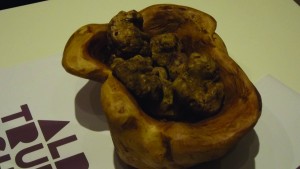
The Fair is held in a large marquee in the Maddalena Courtyard in the centre of town. As I headed towards it I passed through narrow streets festooned with the flags of the different areas of the town. There are nine borghi in total and these take part in the Donkey Palio, a race which is held the weekend before the Fair starts and includes processions of locals dressed up in medieval costumes. I wondered why they use donkeys rather than horses, as in the Palio in Siena. I was told Alba and the nearby town of Asti have always been enemies and as Asti has always held a famous palio, the inhabitants of Alba decided to run the Palio degli Asini to poke fun at their neighbours.
As I entered the Fair my senses were immediately hit by the noise and the pungent aroma of truffles. Where to start was the problem. There were myriad stalls, all selling various local products such as cheese, hazelnuts, wine, and even body lotions made of asses’ milk. However, the stalls of truffles outnumbered all the others, as they should, with various local characters standing behind them trying to sell their wares. The judges’ stand in the middle of the Fair was staffed by local experts. I spoke to one of the judges whose family had been truffle hunters for five generations and he told me tales about the fierce rivalry between truffle hunters. At the far end of the Fair were the wine stalls where you could have great fun trying out an amazing selection of wines. You could even get a wine glass carrier to put around your neck to facilitate all the wine tasting you wanted to do. There was a café selling meals using all the local products so I thought I would try it out and rest my weary legs. After a fried egg topped with shavings of white truffle and a glass of one of the local wines I was rejuvenated and raring to go again.
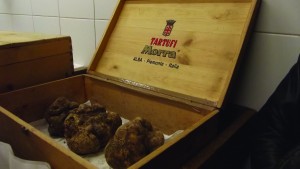 In the afternoon I was invited to go a truffle sensory analysis event where I learnt all about white truffles and was allowed to touch, squeeze and smell them. Here I learned that the white truffles of Alba are considered the finest in Italy and that there are several other types of truffle. As well as the white truffle there is the black truffle, which is often found in Umbria, the summer, or scorzone, truffle, the bianchetto or marzuolo truffle, the black winter truffle and the smooth black truffle. I also learned that truffles found under different types of trees could vary considerably in colour, smell and size. The trees you usually find them under are oak, poplar, aspen and goat willow. Truffle hunting is allowed from late summer to early winter but the white truffle reaches full maturity around the middle of October. Truffles only grow wild and to date no cultivation techniques exist. This particular season has been a good one for truffles, with a wet summer and a sunny autumn. This makes the price a bit more affordable. This year truffles are being sold for €2,000 (£1,580) a kilogram. This is down from €3,500 last year and €5,000 in 2012. Truffles have to be eaten as soon as possible. They cannot be kept any longer than a week. The best way of storing them is by wrapping them up in kitchen roll and putting them in an airtight glass jar and keeping them cool.
In the afternoon I was invited to go a truffle sensory analysis event where I learnt all about white truffles and was allowed to touch, squeeze and smell them. Here I learned that the white truffles of Alba are considered the finest in Italy and that there are several other types of truffle. As well as the white truffle there is the black truffle, which is often found in Umbria, the summer, or scorzone, truffle, the bianchetto or marzuolo truffle, the black winter truffle and the smooth black truffle. I also learned that truffles found under different types of trees could vary considerably in colour, smell and size. The trees you usually find them under are oak, poplar, aspen and goat willow. Truffle hunting is allowed from late summer to early winter but the white truffle reaches full maturity around the middle of October. Truffles only grow wild and to date no cultivation techniques exist. This particular season has been a good one for truffles, with a wet summer and a sunny autumn. This makes the price a bit more affordable. This year truffles are being sold for €2,000 (£1,580) a kilogram. This is down from €3,500 last year and €5,000 in 2012. Truffles have to be eaten as soon as possible. They cannot be kept any longer than a week. The best way of storing them is by wrapping them up in kitchen roll and putting them in an airtight glass jar and keeping them cool.
A guided tour around Alba was my next treat. We were told that once, 100 or more towers filled the medieval skyline but now there are only 20. We saw Roman remains dating back to when it was the colony of Alba Pompeia. We toured some of the beautiful churches and other buildings, but the highlight of the tour for me was visiting Tartufi Morra, a truffle shop that was founded in 1930 by Giacomo Morra. He was the person responsible for starting the Alba Truffle Fair and it is because of him that Alba became so well known throughout the world for its white truffles. And it was his inspired idea to award a truffle to a famous personality of the day.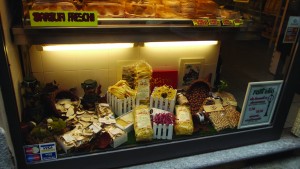
Later, as I walked through the Piazza Risorgimento, we came across a medieval game of pantalera being played. Pantalera is a variation on the traditional Piedmontese game of pallapugno, or ‘fistball’. Players wrap their fists in strips of cloth with a moulded piece of leather and a strip of rubber on top as a shock absorber and to help the players direct the ball. The game is historically rooted in Southern Piedmont and Liguria, where it is played professionally.
The next morning I decided to have a relaxing walk around Alba to soak up the atmosphere. There were stalls selling local products including truffles on every street corner and in the main Piazza near the Duomo was a herb and spice market full of colourful and aromatic stalls. As I walked down the main street I mixed with visitors and locals all enjoying a Sunday morning stroll. The weather was misty and autumnal but still very warm for October. The shop windows were full of all sorts of foodie delights, which tempted and tantalised me as I wandered by. Oh, to be able to take a suitcase full of them home to share!
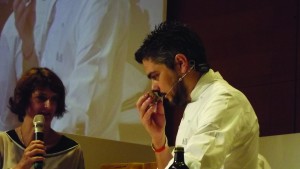 After a delicious lunch, off I went on the most anticipated part of my weekend. A truffle hunt in the Piedmont countryside with a local truffle hunter and his dog. There are 4,000 licenced truffle hunters in Piedmont, who have to pass an exam and pay a €140 tax each year. Truffle hunters, or trifolau as they are known, have to have an unparalleled knowledge of the local area, and a great relationship with their dog, and great skill in extracting the truffle from the ground without it being damaged. It seemed to me that they had to have the skill of a surgeon and the delicacy of an archaeologist. The dogs are an essential part of the hunt. They must have stamina and a highly developed sense of smell, and be obedient to their masters. It is believed that mongrels are better for the job than a pedigree dog. They are known in Piedmont as taboj (pronounced ‘tabui’). They start their training young and can even attend a special university for truffle dogs in Roddi, the ‘Università dei Cani da Tartufo’, which was established in 1880. A truffle hunter’s kit consists of a stick with a curved handle for support on steep slopes and to move away soil, a torch and a tool for digging, a bag of some sort to carry the prized truffles in, and some sort of reward for the dog for sniffing them out. I was really surprised how quickly the dog found a truffle after we started the truffle hunt. The truffle hunter had to move really quickly to get there before the dog dug up the truffle itself. As the truffle hunter talked to us all, the dog was off, back on the hunt for another one. It was fascinating to watch the truffle being carefully dug out the ground. I was even offered the chance to dig one up but I declined, being worried that I might damage it. They are not called “grey diamonds” for nothing.
After a delicious lunch, off I went on the most anticipated part of my weekend. A truffle hunt in the Piedmont countryside with a local truffle hunter and his dog. There are 4,000 licenced truffle hunters in Piedmont, who have to pass an exam and pay a €140 tax each year. Truffle hunters, or trifolau as they are known, have to have an unparalleled knowledge of the local area, and a great relationship with their dog, and great skill in extracting the truffle from the ground without it being damaged. It seemed to me that they had to have the skill of a surgeon and the delicacy of an archaeologist. The dogs are an essential part of the hunt. They must have stamina and a highly developed sense of smell, and be obedient to their masters. It is believed that mongrels are better for the job than a pedigree dog. They are known in Piedmont as taboj (pronounced ‘tabui’). They start their training young and can even attend a special university for truffle dogs in Roddi, the ‘Università dei Cani da Tartufo’, which was established in 1880. A truffle hunter’s kit consists of a stick with a curved handle for support on steep slopes and to move away soil, a torch and a tool for digging, a bag of some sort to carry the prized truffles in, and some sort of reward for the dog for sniffing them out. I was really surprised how quickly the dog found a truffle after we started the truffle hunt. The truffle hunter had to move really quickly to get there before the dog dug up the truffle itself. As the truffle hunter talked to us all, the dog was off, back on the hunt for another one. It was fascinating to watch the truffle being carefully dug out the ground. I was even offered the chance to dig one up but I declined, being worried that I might damage it. They are not called “grey diamonds” for nothing.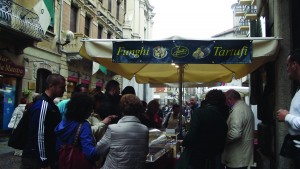
The truffle hunt took place near one of the vineyards belonging to the Ceretto family, where we were going to a wine tasting session. As we finished the truffle hunt, Roberta Ceretto came down the hill to meet us and take us up their Monsordo Bernardina estate. This century-old farmhouse has been transformed into a modern and well-equipped head office. As we entered, the smell of wine was overpowering. We were taken to the wine tasting area where there were stupendous views of the vineyards, especially from “The Grape” a specially-built, totally transparent structure which overlooks the vineyards. We tried three different Ceretto wines, including Barolo. They were all wonderful. The Ceretto family also own two restaurants: the Piazza Duomo restaurant, which has three Michelin stars, and La Piola restaurant – both are in the main square of Alba. The family own the Relanghe Nougat factory too, which makes the traditional Piedmont nougat made from the honey and hazelnuts of the area. The Ceretto family likes to support art events in the local area and while I was in Alba I visited one of their projects, an exhibition by Anselm Kiefer called Der Rhein, in the Maddalena church in the centre of town.
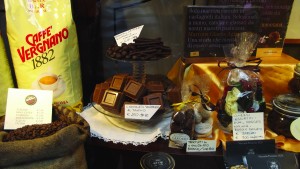 To continue on the wine theme, my next destination was the Banca del Vino in Pollenzo, near Bra, about six miles from Alba. It is a wine bank that collects as many wines from Italy as possible. It hosts wine tours and tastings and other events to promote the image and culture of wine. It is run by the Slow Food Movement, founded by Carlo Petrini in Italy in 1986. The Slow Food Movement is promoted as an alternative to fast food and tries to preserve traditional and regional cuisine. There is also a University of Gastronomic Sciences nearby, where students from all over the world come to study food – this is also run by the Slow Food Movement.
To continue on the wine theme, my next destination was the Banca del Vino in Pollenzo, near Bra, about six miles from Alba. It is a wine bank that collects as many wines from Italy as possible. It hosts wine tours and tastings and other events to promote the image and culture of wine. It is run by the Slow Food Movement, founded by Carlo Petrini in Italy in 1986. The Slow Food Movement is promoted as an alternative to fast food and tries to preserve traditional and regional cuisine. There is also a University of Gastronomic Sciences nearby, where students from all over the world come to study food – this is also run by the Slow Food Movement.
My wonderful weekend in this beautiful area was now drawing to a close but I have vowed to return as soon as I possibly can to discover more of its plentiful charms.
Click here to plan your trip to this year’s Alba White Truffle Fair!
